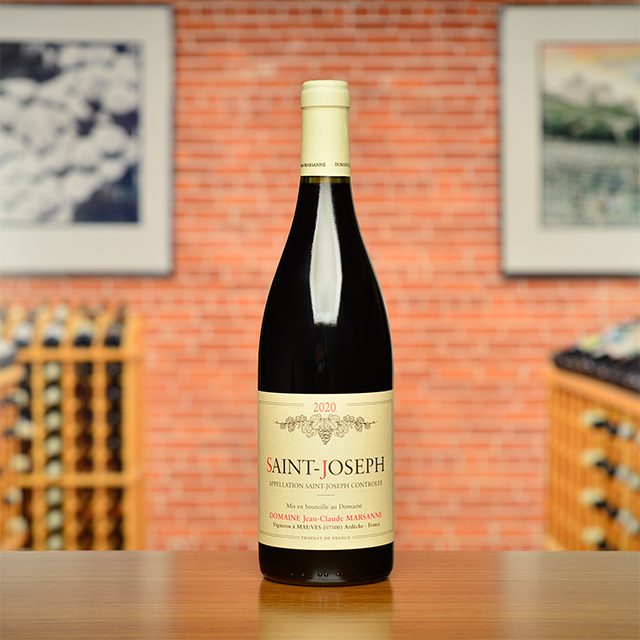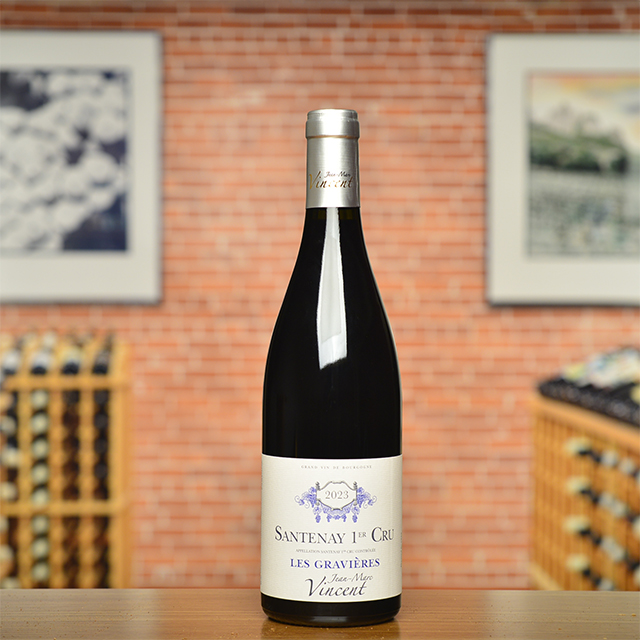Notify me
2018 Saint-Joseph Blanc
Jean-Claude Marsanne
Apricots, almonds, and, above all, finesse. If I had to pick a single wine to show how great a Marsanne (in all senses of the word) can be, this would be it. The long, inviting, bitter notes on the finish are truly remarkable. Quantities are sadly small.
—Chris Santini
| Wine Type: | white |
| Vintage: | 2018 |
| Bottle Size: | 750mL |
| Blend: | Marsanne |
| Appellation: | Saint-Joseph |
| Country: | France |
| Region: | Northern Rhône |
| Producer: | Domaine Jean-Claude Marsanne |
| Winemaker: | Jean-Claude Marsanne |
| Vineyard: | Planted in 1990, 1995, and 2010, .85 ha |
| Soil: | Clay, granite |
| Aging: | Fermented in tonneaux for 6 weeks before being racked to smaller barrels. Wine ages for 11 months in 228L barrels |
| Farming: | Lutte Raisonnée |
| Alcohol: | 13.5% |
More from this Producer or Region

2023 Saint-Joseph Rouge
France | Northern Rhône
The kind of Saint-Jo to dig into right away: smoky, layered, lush, and laced with violet, bay leaf, and black olive.

2021 Côte-Rôtie “Besset”
France | Northern Rhône
From the classic aromas of graphite, black fruit, and roasted spice, to the total finesse of its tannins, this is Côte-Rôtie at its best.

2001 Côte-Rôtie
France | Northern Rhône
The great northern Rho?ne wines of yesteryear still exist today, and this is one of them.

2020 Saint-Joseph Rouge
France | Northern Rhône
The kind of Saint-Jo to dig into right away: smoky, layered, lush, and laced with violet, bay leaf, and black olive.

2022 Côte-Rôtie “La Boisselée”
France | Northern Rhône
November Club Chevalier ~ Made from six vineyards that, when blended, showcase the whole of the Côte Rôtie appellation.

2023 Crozes-Hermitage Rouge
France | Northern Rhône
This small parcel has a fruit-forward, approachable style, yet with intense spice and licorice in there as well, perhaps from the deep-rooted old Syrah vines.

2022 Saint-Joseph Rouge “L’Instinct”
France | Northern Rhône
It is a real-deal northern Rhône roasted-slope Syrah that walks the tightrope perfectly between creamy fruit, meaty tannins, and fresh spine.

2021 Saint-Joseph Blanc
France | Northern Rhône
Like eating lemon curd at a party that Renoir might have painted—think something like Dance at Le Moulin de la Galette.

2023 Ardèche Syrah “Syrah Mauve”
France | Northern Rhône
Young vines in Mauves, short maceration, stainless-steel aged... but definitely no simple Syrah!

2023 Saint-Joseph Rouge
France | Northern Rhône
From high-altitude slopes above the Rhône river, this Syrah exhibits remarkable purity and grace.
 /
/
About The Producer
Domaine Jean-Claude Marsanne
The Marsanne family, as their name attests, has a long and deep-rooted history in the northern Rhône, in particular around Mauves, the birthplace of the Saint-Joseph appellation. In 1920, current owner Jean-Claude’s grandfather, Jean-Pierre, became the first in the family to focus solely on vineyards—no easy task given the impossibly steep slopes of Mauves, where everything must be worked by hand and pickaxe. Jean-Pierre started with just a few small parcels, selling off his crop to prestigious négociants, and was quickly renowned throughout the region for the exceptional quality of his grapes. His untimely passing in 1950 forced his son, Jean, to quit school at age 16 to take over the domaine. He continued his father’s work in earnest, his vineyards often being recognized amongst the village’s best, not just for their exposition and soil, but also for the attention to detail young Jean paid to each vine. The grape sales financed some small land purchases in and around Mauves, and the domaine slowly grew to 3 hectares. In 1970, Jean made the leap to begin making and bottling the wines himself. Over time, a small, but loyal following developed, especially among France’s fine dining establishments, which valued the finesse and elegance of Marsanne’s cuvées. The domaine remained largely unknown on the international scene, overlooked by many journalists and clients who sought out bolder, more extracted styles.
Since taking over from Jean in 1991, Jean-Claude has continued to add select new parcels, growing the domaine to 9.6 hectares. While still mostly focused on Syrah from the hallowed terroir of Mauves, he now farms a few small plots of Marsanne for his Saint-Joseph blanc, as well as some Viognier and Syrah in the Ardèche hills west of the village. He also inherited a superb plot of Crozes-Hermitage that once belonged to his grandmother.
Kermit came across Jean Marsanne during his early adventures in France in the 1970s, and was struck by the wines’ aromatic complexity and Jean’s meticulous care for the vineyards. He even managed to import a few bottles in those early days. Kermit and the Marsannes lost touch and life went on, until decades later when Kermit spotted a familiar label while dining out in Paris. The bottle was ordered, uncorked, and an old collaboration was renewed.
Jean-Claude holds tightly to the traditions of his family. These include farming the steepest parcels by hand, as was done by his grandfather; using indigenous yeasts for slow, natural fermentations, like his father taught him; and aging his wines extensively on fine lees, releasing each cuvée at its most expressive moment. The reunion with Marsanne is one of great pride on both sides.
More from Northern Rhône or France
2022 Côte-Rôtie “La Boisselée”
Barruol / Lynch France | Northern Rhône
2020 Côte-Rôtie “Fongeant”
Barruol / Lynch France | Northern Rhône
2023 Vin de France Blanc “Cuvée de Louis”
Domaine Jolivet France | Northern Rhône
2022 Côte-Rôtie “Emporium”
Lionel Faury France | Northern Rhône
2021 Côte-Rôtie
Domaine Jamet France | Northern Rhône
2022 Saint-Joseph Rouge “L’Instinct”
Domaine Jolivet France | Northern Rhône
2023 Saint-Joseph Blanc “Clef de Sol”
Domaine Jolivet France | Northern Rhône
2022 Côte-Rôtie
Domaine Jamet France | Northern Rhône
2023 Ardèche Syrah “Syrah Mauve”
Domaine Jean-Claude Marsanne France | Northern Rhône
2023 Saint-Joseph Rouge “Châtelet”
Domaine Monier Perréol France | Northern Rhône
2023 Saint-Joseph Rouge “Terre Blanche”
Domaine Monier Perréol France | Northern Rhône
2016 Cornas “Reynard”
Thierry Allemand France | Northern Rhône
2022 Côte-Rôtie “La Boisselée”
Barruol / Lynch France | Northern Rhône
2020 Côte-Rôtie “Fongeant”
Barruol / Lynch France | Northern Rhône
2023 Vin de France Blanc “Cuvée de Louis”
Domaine Jolivet France | Northern Rhône
2022 Côte-Rôtie “Emporium”
Lionel Faury France | Northern Rhône
2021 Côte-Rôtie
Domaine Jamet France | Northern Rhône
2022 Saint-Joseph Rouge “L’Instinct”
Domaine Jolivet France | Northern Rhône
2023 Saint-Joseph Blanc “Clef de Sol”
Domaine Jolivet France | Northern Rhône
2022 Côte-Rôtie
Domaine Jamet France | Northern Rhône
2023 Ardèche Syrah “Syrah Mauve”
Domaine Jean-Claude Marsanne France | Northern Rhône
2023 Saint-Joseph Rouge “Châtelet”
Domaine Monier Perréol France | Northern Rhône
2023 Saint-Joseph Rouge “Terre Blanche”
Domaine Monier Perréol France | Northern Rhône
2016 Cornas “Reynard”
Thierry Allemand France | Northern Rhône
Kermit once said...

Kermit once said...
Let the brett nerds retire into protective bubbles, and whenever they thirst for wine it can be passed in to them through a sterile filter. Those of us on the outside can continue to enjoy complex, natural, living wines.
Inspiring Thirst, page 236














